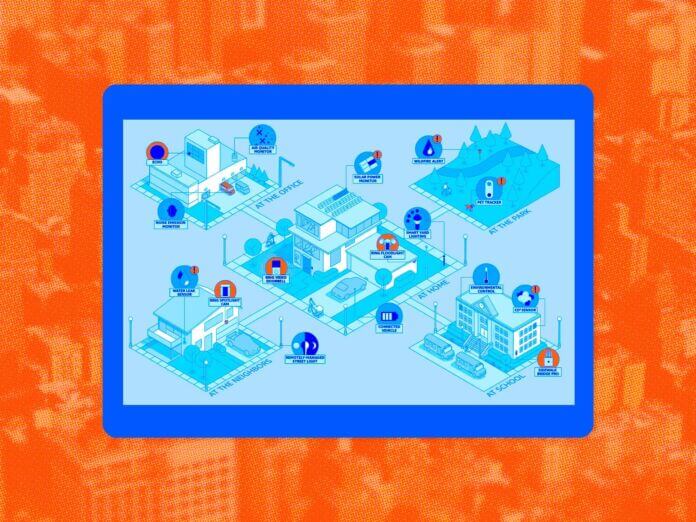
Amazon Sidewalk is a secure, low bandwidth, low power, long-distance network with 90 percent coverage in the U.S. The infrastructure consists of participating Amazon Devices (called Sidewalk Bridges) which use a small amount of the host network’s bandwidth to create the Sidewalk network.
It is explicitly designed for devices that need to send very small amounts of data over longer distances and where connectivity to private network infrastructure isn’t practical or cost-effective. Launched June 8th, Amazon Sidewalk, specifically along the margins of your property, promises to keep your home devices better linked.
The general idea is that a few Ring devices and Amazon Echo smart speakers will act as bridges, enabling long-distance connections with other Sidewalk-enabled devices via wireless Bluetooth LE or 900MHz LoRa signals in addition to a tiny amount of your home network’s capacity.
By doing this, these gadgets will form a sort of mesh network, with your Echo or Ring serving as a bridge between your router and, for example, those smart outdoor lights that are right at the edge of the Wi-Fi range.
Sidewalk isn’t a mesh network, in contrast to, say, Z-Wave. It is an LPWAN, or low-power wide-area network, which was designed with the Internet of Things (IoT) devices in mind. It works well for transferring small amounts of data across surprisingly long distances securely and confidentially.
In terms of functionality, Sidewalk is similar to Apple’s Find My network, which enables the tracking of any Apple device with an Apple phone, tablet, or computer. By allowing any object, such as a lost iPhone, to connect to any other Apple device owned by anybody else, it does this.
Comparing to Apple’s Find My network, the hardware for Sidewalk is made up of millions of Amazon’s smart speakers and security camera models.
Amazon appears to be serious about Sidewalk security; the company says it can’t see anything but routing data on Sidewalk network traffic. Owners of Bridge devices (cameras and smart speakers) can’t see any data or who’s connecting.
And data is protected by three layers of encryption. The company uses what is essentially the zero-trust model, requiring only Sidewalk devices to connect and authenticate each device at the serial number level each time they want to communicate via the system. Privacy and anonymity are affected by using one-way hashing keys, cryptographic algorithms, and rotating device IDs.
Benefits of Amazon Sidewalk
By far the biggest advantage of choosing Sidewalk over other solutions is savings in infrastructure implementation cost and maintenance costs. Since the infrastructure is already there, and is maintained by Amazon, it negates the single biggest obstacle in implementing most wide area-based IoT solutions.
Another advantage of Amazon Sidewalk is range. Devices can connect from up to half a mile away. Devices are not limited to a specific area. You can connect Sidewalk-enabled devices anywhere in the country.
Limitations of Amazon Sidewalk
Amazon Sidewalk is ideal for Smart City and other connected device solutions which send very small amounts of data over long distances. It is not, however, suitable for higher bandwidth applications. Amazon Sidewalk has a data cap of 500 MB per month, so the frequency of messages from devices must be planned so capacity is not exceeded.
Amazon Sidewalk & Smart Cities
Sidewalk goes beyond just connecting outdoor lights and smart home devices. It is designed to facilitate connectivity for various gadgets, not just for your personal use.
For instance, if your neighbor has a Sidewalk-enabled mailbox sensor that is within range of the Sidewalk bridges in your home, that sensor may utilize your network to establish a connection with the cloud.
The possibilities for Smart City IoT solutions using Amazon Sidewalk are endless. It allows the flexibility of rapidly deploying an IoT solution without having to wait on the infrastructure to be built. Some common use cases might include:
- Automated utility meter monitoring. Metering data from gas, water, and electricity can be sent via Amazon Sidewalk negating the need for proximity meter scans or manual meter readings.
- Tracking of equipment. Keep track of valuable equipment should it become misplaced or stolen by affixing a low-cost Amazon Sidewalk-based locator device.
- Sensors of every kind imaginable to monitor and report on anything from temperatures, rainfall/humidity, parking utilization, traffic counters, and many others!
Current Market
Sidewalk-enabled devices already exist on the market. As we mentioned above, there are already home sensor clusters that monitor air conditioning and water leaks, water-leak sensors, gas alarms, smart door locks, natural gas alarms, and air quality sensors.
Amazon recently announced the Sidewalk Bridge Pro by Ring, a professional-grade bridge for businesses, municipalities, universities, and public services.
In a statement, Amazon said: “Since launching Amazon Sidewalk, Amazon has seen the network rapidly grow in residential areas nationwide, helping customers’ devices work harder inside homes, outside, and around the neighborhood.” But the benefits of Sidewalk can extend even further.
The Sidewalk Bridge Pro will provide connectivity to devices such as sunlight sensors, air quality monitors, and moisture sensors. The device is optimized for longer range and greater capacity, with the ability to simultaneously connect to hundreds of devices over five miles away. It also has ruggedized housing to withstand outdoor conditions and comes with the option to add indoor or outdoor antennas.
- SEO Powered Content & PR Distribution. Get Amplified Today.
- PlatoData.Network Vertical Generative Ai. Empower Yourself. Access Here.
- PlatoAiStream. Web3 Intelligence. Knowledge Amplified. Access Here.
- PlatoESG. Automotive / EVs, Carbon, CleanTech, Energy, Environment, Solar, Waste Management. Access Here.
- PlatoHealth. Biotech and Clinical Trials Intelligence. Access Here.
- ChartPrime. Elevate your Trading Game with ChartPrime. Access Here.
- BlockOffsets. Modernizing Environmental Offset Ownership. Access Here.
- Source: https://www.iotforall.com/what-is-amazon-sidewalk-and-how-to-use-it-in-your-smart-city-project
- :has
- :is
- :not
- :where
- $UP
- 1
- 500
- 8th
- 90
- a
- ability
- About
- above
- across
- Act
- add
- addition
- ADvantage
- AIR
- Air Conditioning
- algorithms
- Allowing
- allows
- along
- already
- also
- Amazon
- Amazon Echo
- amount
- amounts
- an
- and
- announced
- Anonymity
- any
- anything
- anywhere
- Apple
- applications
- ARE
- AREA
- areas
- around
- AS
- At
- authenticate
- away
- Bandwidth
- BE
- become
- benefits
- Better
- between
- Beyond
- Biggest
- bluetooth
- BRIDGE
- bridges
- built
- businesses
- but
- by
- called
- camera
- cameras
- CAN
- cap
- Capacity
- cases
- choosing
- City
- Cloud
- comes
- Common
- communicate
- company
- computer
- conditions
- Connect
- connected
- Connected Device
- Connecting
- connection
- Connections
- Connectivity
- consists
- contrast
- Cost
- cost-effective
- Costs
- counters
- country
- coverage
- create
- cryptographic
- data
- deploying
- designed
- device
- Devices
- does
- doing
- Door
- each
- echo
- Edge
- electricity
- else
- enables
- enabling
- encryption
- Endless
- equipment
- essentially
- establish
- Ether (ETH)
- Even
- Every
- example
- exceeded
- exist
- extend
- facilitate
- far
- few
- Find
- five
- Flexibility
- For
- form
- Frequency
- from
- functionality
- further
- Gadgets
- GAS
- General
- Goes
- greater
- Grow
- Half
- harder
- Hardware
- hashing
- having
- helping
- higher
- Home
- Homes
- host
- housing
- How
- How To
- However
- HTTPS
- Hundreds
- idea
- ideal
- ids
- if
- implementation
- implementing
- in
- include
- Indoor
- Infrastructure
- inside
- instance
- Internet
- internet of things
- iot
- iPhone
- IT
- jpg
- june
- just
- Keep
- keys
- Kind
- launched
- launching
- layers
- Leaks
- Level
- Limited
- linked
- Locks
- Long
- longer
- lost
- Low
- low-cost
- made
- maintenance
- manual
- many
- margins
- Market
- max-width
- May..
- mentioned
- mesh
- Mesh network
- messages
- might
- millions
- mind
- misplaced
- model
- models
- Monitor
- monitoring
- monitors
- Month
- most
- Municipalities
- must
- my
- Nationwide
- Natural
- Natural Gas
- Need
- network
- network traffic
- number
- object
- obstacle
- of
- on
- only
- optimized
- Option
- or
- Other
- Outdoor
- outside
- over
- owned
- owners
- parking
- participating
- per
- percent
- personal
- phone
- planned
- plato
- Plato Data Intelligence
- PlatoData
- possibilities
- power
- Practical
- privacy
- private
- Pro
- project
- promises
- property
- protected
- provide
- public
- quality
- range
- rapidly
- recently
- report
- residential
- right
- Ring
- router
- routing
- s
- Said
- Savings
- say
- says
- scans
- secure
- securely
- security
- see
- seen
- send
- sensors
- sent
- serial
- serious
- Services
- serving
- should
- signals
- similar
- simultaneously
- since
- single
- small
- smart
- Smart City
- Smart Speakers
- So
- solution
- Solutions
- some
- speakers
- specific
- specifically
- Statement
- stolen
- such
- suitable
- sunlight
- system
- Tablet
- terms
- that
- The
- There.
- These
- they
- things
- this
- those
- three
- time
- to
- track
- Tracking
- traffic
- Transferring
- u.s.
- Universities
- use
- uses
- using
- utility
- utilize
- Valuable
- various
- very
- via
- wait
- want
- was
- Water
- we
- WELL
- What
- What is
- which
- Wi-fi
- wide
- will
- wireless
- with
- within
- without
- Work
- works
- you
- Your
- zephyrnet








